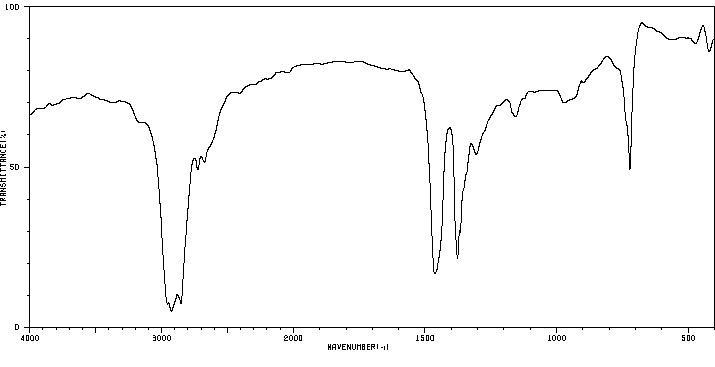cesium bromide
分子结构分类
-
物化性质
-
计算性质
-
ADMET
-
安全信息
-
SDS
-
制备方法与用途
-
上下游信息
-
文献信息
-
表征谱图
-
同类化合物
-
相关功能分类
-
相关结构分类
计算性质
-
辛醇/水分配系数(LogP):-5.99
-
重原子数:2
-
可旋转键数:0
-
环数:0.0
-
sp3杂化的碳原子比例:0.0
-
拓扑面积:0
-
氢给体数:0
-
氢受体数:1
ADMET
反应信息
-
作为反应物:描述:3,5-difluoro-1,2,4,6-thiatriazin-1-ium;hexafluoroarsenic(1-) 、 cesium bromide 以78%的产率得到参考文献:名称:FISCHER, EBERHARD;JAODAS-PREZEL, EVELINE;MAGGIULLI, ROBERTO;MEWS, RUDIGER+, CHEM. BER., 124,(1991) N, C. 1347-1352摘要:DOI:
-
作为试剂:描述:BOC-D-色氨酸 、 Dicaesio carbonate 、 3-溴-2-丁酮 、 乙酸铵 在 cesium bromide 、 水 、 碳酸氢钠 、 Brine 、 magnesium sulfate 、 silica gel 作用下, 以 乙醇 、 N,N-二甲基甲酰胺 、 邻二甲苯 、 乙酸乙酯 、 水 为溶剂, 反应 3.75h, 以to afford 3 g of the desired product as a white powder的产率得到Tert-butyl (1R)-1-(4,5-Dimethyl-1,3-oxazol-2-yl)-2-(1H-indol-3-yl)ethylcarbamate参考文献:名称:&bgr;-carboline compounds摘要:本发明涉及一种公式化合物,其中变量在规范中定义,其能够结合生长抑素受体并阻断Na通道。公开号:US06586445B1
文献信息
-
Octadecylamine‐Functionalized Single‐Walled Carbon Nanotubes for Facilitating the Formation of a Monolithic Perovskite Layer and Stable Solar Cells作者:Vincent Tiing Tiong、Ngoc Duy Pham、Teng Wang、Tianxiang Zhu、Xinluo Zhao、Yaohong Zhang、Qing Shen、John Bell、Linhua Hu、Songyuan Dai、Hongxia WangDOI:10.1002/adfm.201705545日期:2018.3approach is developed to synthesize perovskite films consisting of monolithic‐like grains with micrometer size through in situ deposition of octadecylamine functionalized single‐walled carbon nanotubes (ODA‐SWCNTs) onto the surface of the perovskite layer. The ODA‐SWCNTs form a capping layer that controls the evaporation rate of organic solvents in the perovskite film during the postthermal treatment由于其优异的光学和电子性能,有机-无机卤化铅钙钛矿具有广阔的应用前景。为了获得高性能的钙钛矿太阳能电池,需要使用具有大晶粒的钙钛矿光吸收层,以便在设备运行期间最大程度地减少晶界和复合。本文中,开发了一种简单而有效的方法,通过将十八烷基胺官能化的单壁碳纳米管(ODA-SWCNT)原位沉积在钙钛矿层的表面上来合成具有微米级尺寸的整体样晶粒的钙钛矿膜。ODA-SWCNT形成覆盖层,该覆盖层控制后热处理过程中钙钛矿膜中有机溶剂的蒸发速率。这种有利的形态反过来大大增强了钙钛矿型太阳能电池的短路电流密度,并几乎完全消除了滞后现象。使用(FA0.83 MA 0.17)0.95 Cs 0.05 Pb(I 0.83 Br 0.17)3作为光吸收剂。此外,具有ODA-SWCNT的钙钛矿太阳能电池表现出非凡的稳定性,在高湿度(60-90%)的环境下经过45天的稳定性测试后,其性能保持率高达80%。这项工作为钙钛
-
Method of producing aromatic carbonate申请人:Mitsubishi Chemical Corporation公开号:US05543547A1公开(公告)日:1996-08-06The present invention relates to a method of producing an aromatic carbonate by reacting an aromatic hydroxy compound, carbon monoxide and oxygen using as a catalyst a specified catalyst system containing palladium and cerium compounds. Specifically, the present invention relates to a method of producing an aromatic carbonate by reacting an aromatic hydroxy compound, carbon monoxide and oxygen in the presence of a catalyst containing the following compounds: (A) at least one selected from palladium and palladium compounds; (B) at least one of trivalent or tetravalent cerium compounds; (C) at least one selected from quaternary ammonium salts and quaternary phosphonium salts; (D) at least one selected from quinones and reduction products thereof, i.e., aromatic diols; or (A) and (B) components of the above; and (E) at least one inorganic halide selected from alkali metal halides and alkali earth metal halides.
-
CsPbBr<sub>3</sub> Perovskite Nanocrystals for Photocatalytic [3+2] Cycloaddition作者:Yixiong Lin、Yong YanDOI:10.1002/cssc.202301060日期:2024.1.8
Abstract Visible‐light‐induced halide‐exchange between halide perovskite and organohalide solvents has been studied in which photoinduced electron transfer from CsPbBr3 nanocrystals (NCs) to dihalomethane solvent molecules produces halide anions via reductive dissociation, followed by a spontaneous anion‐exchange. Photogenerated holes in this process are less focused. Here, for CsPbBr3 in dibromomethane (DBM), we discover that Br radical (Br⋅) is a key intermediate resulting from the hole oxidation. We successfully trapped Br⋅ with reported methods and found that Br⋅ is continuously generated in DBM under visible light irradiation, hence imperative for catalytic reaction design. Continuous Br⋅ formation within this halide‐exchange process is active for photocatalytic [3+2] cycloaddition for vinylcyclopentane synthesis, a privileged scaffold in medicinal chemistry, with good yield and rationalized diastereoselectivity. The NC photocatalyst is highly recyclable due to Br‐based self‐healing, leading to a particularly economic and neat heterogeneous reaction where the solvent DBM also acts as a co‐catalyst in perovskite photocatalysis. Halide perovskites, notable for efficient solar energy conversion, are demonstrated as exceptional photocatalysts for Br radical‐mediated [3+2] cycloaddition. We envisage such perovskite‐induced Br radical strategy may serve as a powerful chemical tool for developing valuable halogen radical‐involved reactions.
摘要 研究了可见光诱导的卤化物过氧化物和有机卤化物溶剂之间的卤化物交换,其中 CsPbBr3 纳米晶体(NCs)和二卤甲烷溶剂分子之间的光诱导电子转移通过还原解离产生了卤化物阴离子,随后发生了自发的阴离子交换。在这一过程中光生成的空穴不太集中。在这里,对于二溴甲烷(DBM)中的 CsPbBr3,我们发现 Br 自由基(Br⋅)是空穴氧化产生的关键中间产物。我们采用已报道的方法成功捕获了 Br⋅,并发现在可见光照射下,DBM 中会持续产生 Br⋅,因此催化反应设计势在必行。在这一卤化物交换过程中,Br⋅的连续生成可用于光催化[3+2]环加成法合成乙烯基环戊烷(药物化学中的一种重要支架),并具有良好的产率和合理的非对映选择性。由于基于 Br 的自修复作用,NC 光催化剂具有很高的可回收性,从而实现了一种特别经济和简洁的异质反应,其中溶剂 DBM 也在过氧化物光催化中起到了辅助催化剂的作用。卤化物过氧化物因其高效的太阳能转换而备受瞩目,已被证明是 Br 自由基介导的 [3+2] 环加成反应的特殊光催化剂。我们设想,这种由包晶石诱导的 Br 自由基策略可作为一种强大的化学工具,用于开发有价值的卤素自由基相关反应。 -
PLETNEV, S. I.;IGUMNOV, S. M.;ZAXAROVA, E. V.;MAKAROV, K. N., IZV. AN CCCP. CEP. XIM.,(1990) N, S. 636-640作者:PLETNEV, S. I.、IGUMNOV, S. M.、ZAXAROVA, E. V.、MAKAROV, K. N.DOI:——日期:——
-
AVETISYAN, EH. A.;CHERSTKOV, V. F.;SNEGIREV, V. F.;STERLIN, S. R.;GERMAN,+, IZV. AN CCCP. CEP. XIM.,(1990) N, S. 695-698作者:AVETISYAN, EH. A.、CHERSTKOV, V. F.、SNEGIREV, V. F.、STERLIN, S. R.、GERMAN,+DOI:——日期:——
表征谱图
-
氢谱1HNMR
-
质谱MS
-
碳谱13CNMR
-
红外IR
-
拉曼Raman
-
峰位数据
-
峰位匹配
-
表征信息







